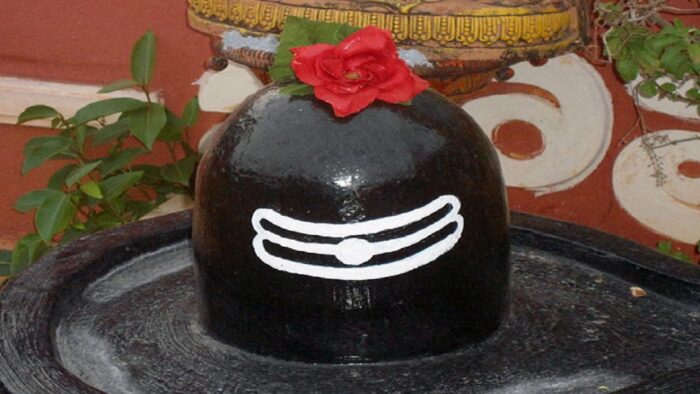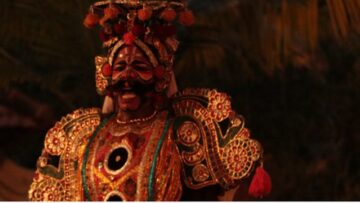Last week, as I prepared for going on a week’s holiday, a friend of mine drew my attention to an article provocatively titled “Excuse me, I do not want to worship a phallus anymore”, which purported to show why it is wrong to worship Shiva Linga, especially for a woman, and why the female author will no longer worship the ‘phallus’. As I read through the short piece expecting some genuine arguments to substantiate the provocative stand taken in the title, all I was left with for munching was half knowledge and pre-conceived notions rooted in skewed feminist narrative and a projection of an Abrahamic male-god narrative onto Hindu traditions. The author also projects Biblical narratives such as man being “made in the image of god. While the author hardly merits a response, this kind of half-knowledge is easily passed around, so it is worth setting it straight, if only to clear a misconception some other Hindus may share.
The two questions I would focus in this article will be:
- Is there anything wrong in phallus worship?
- What actually is Shiva Linga all about?
Let us take one at a time.
Is there anything wrong in phallus worship?
A short and straight answer is a No. There is nothing wrong in worshiping, any of the body portions, be it phallus or yoni, or face, or the feet. In a Dharmic tradition like Hinduism, where a Shaiva devotee like Basavanna described the body as the temple and legs its pillars; a tradition where the devotees have built a temple at each of the 51 places, where a part of the body of the Goddess Sati is supposed to have fallen, the question of inappropriateness of phallus worship does not arise at all! The above is a reference to the 51 Shakti peethas, which includes Kamakhya, where the yoni of the Goddess is supposed to have fallen and where the Yoni itself has been worshipped for many centuries now!
The worship of phallus or yoni specifically derives its meaning and context from the tantric traditions. Though, we can see the worship of Goddess as a Yoni in Kamakhya and the celebration of menstruation in different forms across the country, the actual practical worship of physical phallus and vagina takes place and has a relevance only in certain tantric traditions, especially those that utilize intercourse to attain samadhi. In these traditions, Linga and Yoni serve as manifestations of cosmic Purusha and Prakriti and they convert intercourse into an act of worship and meditation. In this context, Yoni Tantra, for example, says: “The vagina is Mahamaya and the phallus is Sadashiva. Worshipping them, one becomes liberated while still alive, there is no doubt about it. Oblation should be with their effusion and with wine and flesh (Patala 5).” The same Tantra in another verse says that during ritualized intercourse, “The Lingam Puja and the Yoni Puja should be done according to the rules. Beloved One, red powder and sandal should be smeared on the lingam (Patala 2).” In yet another place, it says “
The highest sadhaka should mix in water the effusion from the Yoni and Lingam, and sipping this Amrita, nourish himself with it (Patala 2).”
Without going into the details, the gist is, the phallus worship serves as a means for worshipping the cosmic Purusha and is a valid path for attaining spiritual emancipation. The phallus serves the same function as any idol, natural elements like fire, or any other means, which are used in the spiritual path for invoking the divine, worshipping the divine and then transcending the mundane by margining with the divine.
Thus, it is only those who have become disconnected from Sanatana Dharma, will take offence at “phallus worship”. Regarding the assertion that Hinduism propagates misogyny because it advocates phallus worship and associates virility, strength, and ability to provide “seed” for conception with phallus, while making women to become apologetic about their menstruation and feel shameful about their breasts, the less said the better. I have written elsewhere in much detail about how in Hindu tradition, menstruation is celebrated and is perceived as a sacred period of rest, austerity, and self-purification. I have also written about how restrictions on entering temples during menstruation is rooted in the understanding of the workings of subtle energies and have nothing to do with misogyny or discrimination. If today, menstruation is seen as an “unavoidable irritation” for which women need to be apologetic or which hampers careers of women, the fault lies not with Hinduism, but elsewhere. Similarly, one only has to look into the long tradition of Kavyas to know how neither breasts nor hips were associated with shame, instead, they were perceived as aspects of women’s identity, which adds to their beauty. Thus, the roots of this association also lies elsewhere. Now coming to phallus worship itself, one does not need to go farther than the Yoni Tantra quoted before, which clearly establishes how phallus worship and yoni worship had equal standing. The text further calls women as divine, as jewels, and as life itself (Patala 7). If phallus is associated with virility, Yoni is considered as the abode of all deities and the very cause of this universe, worshipping which one attains everything. Thus, the text enunciates “At the Yoni base is Devi, and in the Yoni Naganandini. Kali and Tara are in the Yoni Chakra, and Chinnamastaka in the hair. Bagalamukhi and Matangi are on the edge of theYoni. In the Yoni aperture are Mahalakshmi, Shodashi, and Bhuvaneshvari. When worshipping the Yoni one certainly worships Shakti (Patala 3)” and further adds: “Listen, Parvati! Krishna, after worshipping Radha’s yoni, became God Krishna. Sri Rama Janaki Nath worshipped Sita’s yoni….. Vishnu, Brahma, the saints, and I (Shiva) myself all were born from a yoni. What knowledge in the three worlds can match the magnificence of the yoni?”
From above, it is clear that in Hindu tradition itself, there is no misogyny as far as perception of phallus and vagina is concerned, nor any misogynic attitudes are attached to linga or yoni worship. While the former is associated with virility, the latter with nourishment; while the former provids the “seed”, the latter transforms the seed into the ‘tree’! It is for this reason that tantric traditions claim “Shiva without Shakti is Shava- a dead body”.
The roots of the disdain for phallus and a subtle attribution of shame and inappropriateness with phallus worship or yoni worship lies in the Victorian worldview, which has been imparted to generation after generation of Indians through colonial education at first, and now through secularized education system. It is this secularized discourse, rooted in Abrahamic worldview, which has carried out this “de-sacredization” project since last 200 years. They have successfully created the artificial division between the sacred and the profane and de-rooted the profane from their sacred roots. Thus, sexual intercourse, which was a sacred act, which was equally a means for bhoga, putra, and moksha, has now been reduced to an act confined only to bedrooms and brothels i.e. only to mundane pleasure! As a corollary, any association of sacredness with sex or sexual symbols like linga or yoni is frowned upon! And now the feminist narrative has only added another layer of distortion in the form of misogyny to the symbol of phallus!
Now let us take up the second question and understand what worship of Shiva Linga is all about; whether Shiva Linga has anything to do with phallus; and if it does, what exactly does it mean?
What actually is Shiva Linga all about?
Linga does not mean phallus alone. In fact, the term is most widely used to mean “a mark, symbol or a spot”. With reference to different bodies, Linga refers to the subtle body. Another meaning of Linga is “Upadhi”, the limitation or the effect. Thus, as I explain elsewhere, Shiva Linga basically means “Shiva’s Symbol”, where the term Shiva, which is defined as “the very nature of chit and ananda” by Adi Shankaracharya refers to Para-Brahman, the supreme transcendent reality. The Shiva-Linga, naturally available or manually consecrated in a temple, serve not only as the representation of the transcendental Nirguna Brahman, but is the very Brahman itself in the Saguna or manifested form. Thus, it is rightly said in the Linga Purana that “Lingam sakshaan maheshwarah”- Shiva-Linga is Shiva itself!
Now, let us take the consecrated Shiva-Linga that is worshipped at temples. They contain two prominent parts: The shaft (or Linga) and the pedestal (or Vedi orYoni). In various scriptures, these parts have been associated with different cosmic principles for the sake of Upasana (worship and meditation). In one such Upasana-Krama (procedure for worship), the shaft is worshipped as Rudra, the pedestal as Vishnu and the hidden root as Brahmaa. And hence, Shiva-Linga as a whole represent the Tri-murtis, the three Saguna manifestations of Para-Brahman presiding over creation, sustenance, and dissolution of the universe. In another Upasana-Krama, the pedestal is the Shakti and the shaft is Shiva and Shiva-Linga as a whole is the representation of cosmic union of Shiva and Shakti. Thus, the scriptural statement: “linga vedi mahadevi, lingam sakshat maheshwarah”- the pedestal is Mahadevi and the shaft is Maheshwara himself. In yet another interpretation, Linga is another name for Prakriti and hence, the shaft represents Prakriti, while the pedestal represents Purusha. Here, the Saguna Brahman i.e. Purusha is worshipped as “Lingin”- the bearer of Linga/Prakriti.
Thus, in all the three Upasana-Kramas prevalent in Hindu traditions, there is no direct correlation between Shiva-Linga and Phallus. Instead, in each Krama, Shiva-Linga acts as a symbol of Para-Brahman, with the Saguna aspect being understood in different ways by associating different cosmic principles to the shaft and pedestal of Shiva-Linga. That, Shiva-Linga represents Shiva as a whole and not phallus as such can also be understood from the fact that in many temples, the Shaft is fitted with a face. Further, the Vibhuti is applied on the shaft in the manner it is applied on the forehead. Then, we have naturally available Shiva-Lingas, which do not have any specific shape and represent the Shiva Tattva, just like the Saligrama, which represents the Vishnu Tattva.
But, does this mean, there is no co-relation at all between Shiva-Linga and phallus worship in any context? The answer again is a no. The only context, where the Linga part of the Shiva-Linga is phallus itself, is the case of certain tantrika rituals mentioned in the previous section. In such specific tantrika rituals involving sexual intercourse, or at least the worship of sexual organs, the phallus of the male sadhaka serves as the representation of cosmic Purusha and the vagina of the female sadhika serves as the representation of the cosmic Prakriti. Thus, the Yoni Tantra quoted before, speaks about phallus being Sadashiva and yoni being Mahamaya in the context of the rituals enunciated in the text. In fact, in certain such Lata-Sadhanas, the male identifies himself with Bhairava and the female with the Bhairavi and they engage in sexual intercourse as an imitation of the cosmic union of Shiva and Shakti and enter into Samadhi. In such rituals, the phallus itself becomes Shiva-Linga and worship is offered to the Shiva-Tattva invoked in the phallus. But, apart from this, in all other contexts, be it the worship of Shiva-Linga at home or in temples, attaching sexual connotations to Shiva-Linga is incorrect, meaningless and misleading. A Shiva-Linga is simply a symbol or sign of the Para-Brahman, which manifests both as the divine masculine-Purusha and the divine feminine-Prakriti, and is yet beyond both of them.
Therefore, unless one is a Tantrika sadhaka, who is into Lata-Sadhanas, the question of “phallus worship” is irrelevant and devotees can worship Shiva-Linga as a manifestation of Para-Brahman by following one of the three Upasana-Kramas mentioned before. And if one is a tantra practitioner of Lata-Sadhanas, then the idea of “worshipping phallus as Sadashiva” being wrong, shameful, misogynist or otherwise inappropriate is absurd.
Naturally, what one worships or doesn’t is always a choice in the Hindu tradition. If one form or practice does not appeal to you, when can always pick another. But it is better to do so with knowledge rather than project feminist narrative or Abrahamic theology and bodily shame onto Hindu practices.
(This article was published by IndiaFacts in 2017)
Disclaimer: The opinions expressed in this article belong to the author. Indic Today is neither responsible nor liable for the accuracy, completeness, suitability, or validity of any information in the article.










